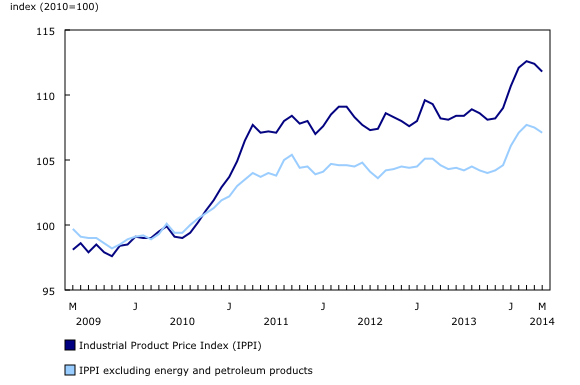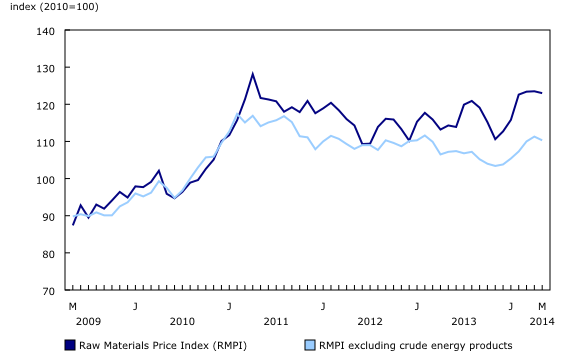Industrial product and raw materials price indexes, May 2014
Archived Content
Information identified as archived is provided for reference, research or recordkeeping purposes. It is not subject to the Government of Canada Web Standards and has not been altered or updated since it was archived. Please "contact us" to request a format other than those available.
Released: 2014-06-27
The Industrial Product Price Index (IPPI) was down 0.5% in May, mainly because of lower prices for energy and petroleum products. The Raw Materials Price Index (RMPI) declined 0.4%, mostly as a result of lower prices for animals and animal products.
Industrial Product Price Index, monthly change
The IPPI declined 0.5% in May, following a 0.2% decrease in April. Of the 21 major product groups, 3 were up, 12 were down and 6 were unchanged.
The decrease of the IPPI was mainly attributable to lower prices for energy and petroleum products (-1.3%). Diesel fuel (-3.2%), light fuel oils (-3.1%) and motor gasoline (-0.4%) were the main reasons for the decline in this commodity group.
Motorized and recreational vehicles (-0.6%) declined for the second consecutive month, led by lower prices for passenger cars and light trucks (-0.8%), motor vehicle engines and motor vehicle parts (-0.3%) and aircraft (-0.9%). The decline of motorized and recreational vehicle prices was closely linked to the appreciation of the Canadian dollar relative to the US dollar.
Chemicals and chemical products (-1.0%) declined for the third consecutive month, led by lower prices for petrochemicals (-3.6%), primarily aromatic hydrocarbon gases (-4.9%) as well as liquefied refinery gases, and acyclic hydrocarbons not elsewhere classified (-4.7%).
The decline of the IPPI was also due to lower prices for meat, fish, and dairy products (-0.7%). Fresh and frozen pork (-5.3%) decreased for the first time since December 2013 and was the main reason for the decline in this commodity group. The decrease in fresh and frozen pork was mainly attributable to lower prices for hogs.
To a lesser extent, primary non-ferrous metal products (-0.5%) declined for the second consecutive month, primarily as a result of lower prices for unwrought precious metals and precious metal alloys (-0.8%) and unwrought aluminum and aluminum alloys (-1.9%). The decline was moderated by higher prices for unwrought copper and copper alloys (+2.8%).
Some Canadian producers who export their products report their prices in US dollars. Consequently, the 0.9% increase in the value of the Canadian dollar relative to the US dollar may have had the effect of decreasing the IPPI. Without the measurable effect of the exchange rate, the index would have fallen 0.3% instead of 0.5%.
Industrial Product Price Index, 12-month change
The IPPI increased 3.4% during the 12-month period ending in May, after rising 3.9% in April.
Compared with May 2013, the growth of the IPPI was mainly attributable to energy and petroleum products (+6.8%), specifically motor gasoline (+5.2%), light fuel oils (+13.2%) and diesel fuel (+11.1%). The IPPI excluding energy and petroleum products rose 2.7% on a year-over-year basis.
Motorized and recreational vehicles (+4.4%) also contributed to the year-over-year increase in the IPPI, as a result of higher prices for passenger cars and light trucks (+4.4%), motor vehicle engines and motor vehicle parts (+3.2%) and aircraft (+8.7%). On a year-over-year basis, prices for motorized and recreational vehicles have been on an upward trend since July 2013.
Compared with May 2013, meat, fish, and dairy products rose 8.3%, mainly due to higher prices for fresh and frozen pork (+34.7%) and fresh and frozen beef and veal (+9.1%).
To a lesser extent, chemicals and chemical products (+3.3%) and the primary ferrous metals group (+9.4%) also contributed to the year-over-year increase in the IPPI.
The gain in chemicals and chemical products was mostly a result of higher prices for plastic resins (+10.8%) as well as ammonia and chemical fertilizers (+11.2%).
The year-over-year advance of primary ferrous metal products (+9.4%) was led by higher prices for iron and steel basic shapes (+12.6%) as well as wire and other rolled and drawn steel products (+8.8%).
Raw Materials Price Index, monthly change
The RMPI decreased 0.4% in May, after edging up 0.1% in April. This was the first decrease of the index since November 2013. Of the six major commodity groups, three were down and three were up.
The decline of the RMPI was largely driven by lower prices for animals and animal products (-2.9%), down for the first time since December 2013. Lower prices for hogs (-9.1%) largely explained the decrease in this commodity group. To a lesser degree, fish, shellfish and other fishery products (-10.5%) also contributed to the decline in the animals and animal products group.
Logs, pulpwood, natural rubber and other forestry products (-0.6%) also pulled the RMPI downward, as prices for natural rubber (-6.1%) declined for a second consecutive month.
The decline of the RMPI was mainly offset by crop products (+0.8%) in May, mostly because of higher prices for other crop products (+0.7%), particularly oilseeds (except canola and soybeans), corn and barley.
The decrease in the RMPI was also moderated by metal ores, concentrates and scrap (+0.2%) and crude energy products (+0.1%).
Raw Materials Price Index, 12-month change
The RMPI rose 7.6% during the 12-month period ending in May, after increasing 9.1% in April.
Compared with the same month a year earlier, the growth of the RMPI was mainly due to higher prices for crude energy products (+12.1%), primarily conventional crude oil (+12.4%). On a year-over-year basis, the RMPI excluding crude energy products was up 2.9%.
To a lesser extent, animals and animal products (+11.9%) also exerted upward pressure on the RMPI, largely because of higher prices for live animals (+21.1%), particularly hogs (+34.2%) and cattle and calves (+20.4%).
The 12-month increase in the RMPI was moderated mainly by crop products (-5.7%), which have been falling on a year-over-year basis since July 2013. The largest contributor to the decline in this commodity group was other crop products (-7.3%), particularly grains (except wheat) as well as canola (-24.5%).
Note to readers
For vectors that have a concordance, Industrial Product Price Index historical data (prior to January 2010) based on the new basket (2010=100) and the North American Product Classification System (NAPCS) are now available on CANSIM.
The concordance between the old CANSIM vectors and the new CANSIM vectors is available in the Concordance table between PCG and NAPCS vectors.
With each release, data for the previous six months may have been revised. The indexes are not seasonally adjusted.
The Industrial Product Price Index (IPPI) reflects the prices that producers in Canada receive as the goods leave the plant gate. It does not reflect what the consumer pays. Unlike the Consumer Price Index, the IPPI excludes indirect taxes and all the costs that occur between the time a good leaves the plant and the time the final user takes possession of it, including the transportation, wholesale and retail costs.
Canadian producers export many goods. They often indicate their prices in foreign currencies, especially in US dollars, which are then converted into Canadian dollars. In particular, this is the case for motor vehicles, pulp, paper and wood products. Therefore, a rise or fall in the value of the Canadian dollar against its US counterpart affects the IPPI. However, the conversion into Canadian dollars only reflects how respondents provide their prices. This is not a measure that takes the full effect of exchange rates into account.
The conversion of prices received in US dollars is based on the average monthly exchange rate (noon spot rate) established by the Bank of Canada, and it is available on CANSIM in table 176-0064 (series v37426). Monthly and annual variations in the exchange rate, as described in the release, are calculated according to the indirect quotation of the exchange rate (for example, CAN$1 = US$X).
The Raw Materials Price Index (RMPI) reflects the prices paid by Canadian manufacturers for key raw materials. Many of those prices are set on the world market. However, as few prices are denominated in foreign currencies, their conversion into Canadian dollars has only a minor effect on the calculation of the RMPI.
Table CANSIM table329-0074: Industrial Product Price Index, by major commodity aggregations.
Table CANSIM table329-0075: Industrial Product Price Index, by commodity.
Table CANSIM table329-0076: Industrial Product Price Index, for selected groups, by region.
Table CANSIM table329-0077: Industrial Product Price Index, by North American Industry Classification System.
Table CANSIM table330-0008: Raw Materials Price Index, by commodity.
Definitions, data sources and methods: survey numbers survey number2306 and survey number2318.
The industrial product and raw materials price indexes for June will be released on July 30.
Contact information
For more information, or to enquire about the concepts, methods or data quality of this release, contact us (toll-free 1-800-263-1136; 514-283-8300; infostats@statcan.gc.ca) or Media Relations (613-951-4636; statcan.mediahotline-ligneinfomedias.statcan@canada.ca).
- Date modified:



